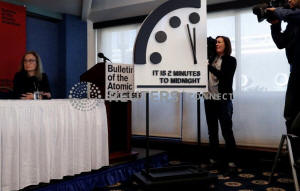|
Nuclear, climate threats keep Doomsday
Clock close to apocalypse
 Send a link to a friend
Send a link to a friend
 [January 26, 2019]
By Peter Szekely [January 26, 2019]
By Peter Szekely
(Reuters) - A renewed nuclear arms race,
rising greenhouse gas emissions and the emergence of state-sponsored
disinformation campaigns have left the modern world as close to
annihilation as it was at the height of the Cold War, atomic scientists
said on Thursday.
The Doomsday Clock, created by the Bulletin of the Atomic Scientists as
an indicator of the world's susceptibility to apocalypse, remained at
two minutes to midnight for a second year running in what the scientists
called a dangerous "new abnormal."
"Though unchanged from 2018, this setting should be taken not as a sign
of stability but as a stark warning to leaders and citizens around the
world," the Chicago-based group said in a statement.
Humanity's two simultaneous existential threats of nuclear war and
climate change were exacerbated during the past year by the "increased
use of information warfare to undermine democracy around the world," the
group said.

"In many forums, including particularly social media, nationalist
leaders and their surrogates lied shamelessly, insisting that their lies
were truth, and the truth 'fake news,'" it said.
Since the election of U.S. President Donald Trump in 2016, the clock has
closed in on midnight in successive 30-second moves in 2017 and 2018, in
part because of escalating tensions with North Korea over its nuclear
program.
The last time the clock was as close to midnight as it has been in the
past two years was in 1953, when the U.S.-Soviet arms race escalated as
Moscow tested a hydrogen bomb in August after the detonation of an
American H-bomb the previous November.
[to top of second column]
|

achel Bronson, president and CEO of the Bulletin of the Atomic
Scientists listens to her fellow members talk about their decision
to move the 'Doomsday Clock' hands to two minutes until midnight at
a news conference in Washington, U.S. January 25, 2018. REUTERS/Leah
Millis

Despite a softening of barbed rhetoric between Trump and North
Korean leader Kim Jong Un over the past year, the group saw rising
threats in nuclear-armed nations' programs of "'nuclear
modernization' that are all but indistinguishable from a worldwide
arms race."
On climate, the group said carbon dioxide emissions resumed an
upward climb in the past two years.
To turn back the clock, it recommended steps including fortifying
and extending U.S.-Russian nuclear treaties with limits on
modernization programs, adopting safeguards to prevent peacetime
military incidents along NATO countries' borders, citizen demands
for action on climate change and multilateral talks to discourage
the misuse of information technology.
The bulletin was founded by scientists who helped develop the United
States' first atomic weapons. When the clock was created in 1947, it
was set at seven minutes to midnight.
(Reporting by Peter Szekely in New York; Editing by Tom Brown)
[© 2019 Thomson Reuters. All rights
reserved.]
Copyright 2019 Reuters. All rights reserved. This material may not be published,
broadcast, rewritten or redistributed.
Thompson Reuters is solely responsible for this content.
 |